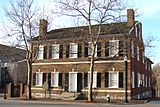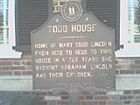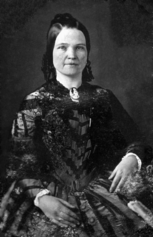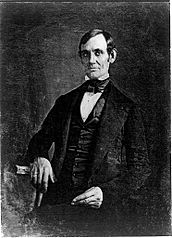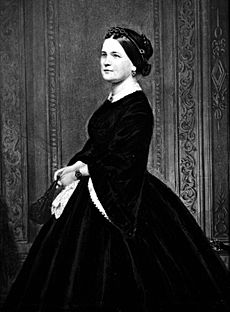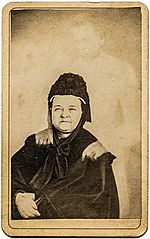Mary Todd Lincoln facts for kids
Quick facts for kids
Mary Todd Lincoln
|
|
|---|---|
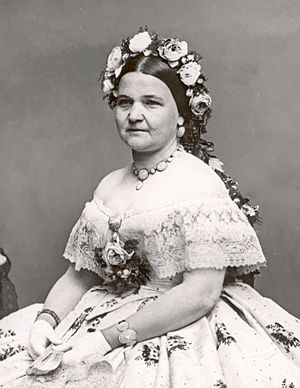
Photograph by Mathew Brady, 1861
|
|
| First Lady of the United States | |
| In role March 4, 1861 – April 15, 1865 |
|
| President | Abraham Lincoln |
| Preceded by | Harriet Lane (acting) |
| Succeeded by | Eliza Johnson |
| Personal details | |
| Born |
Mary Ann Todd
December 13, 1818 Lexington, Kentucky, U.S. |
| Died | July 16, 1882 (aged 63) Springfield, Illinois, U.S. |
| Cause of death | Stroke |
| Resting place | Lincoln Tomb, Oak Ridge Cemetery, Springfield, Illinois, U.S. |
| Spouse | |
| Children | |
| Parents | Robert Smith Todd Elizabeth Ann Parker Todd |
| Signature | |
Mary Todd Lincoln (born Mary Ann Todd; December 13, 1818 – July 16, 1882) was the First Lady of the United States from 1861 to 1865. She was married to President Abraham Lincoln.
Mary grew up in a large, wealthy family in Kentucky. She received a good education. She later moved to Springfield, Illinois, to live with her sister. There, she met and married Abraham Lincoln. They had four sons, but only their oldest son, Robert, lived longer than both parents. Their family home in Springfield is now a historic site.
As First Lady, Mary strongly supported her husband during the American Civil War. She helped keep spirits high in the country. She also managed social events at the White House and redecorated it. Her spending on these projects sometimes caused concern. Mary was sitting next to President Lincoln when he was shot at Ford's Theatre in Washington, D.C., in 1865. The deaths of her husband and three of her sons caused her great sadness.
Mary Lincoln faced many health challenges throughout her life. She often had severe headaches and periods of deep sadness. Some historians believe she might have had bipolar disorder, a condition that affects mood. She briefly stayed in a special hospital in 1875 but later returned to her sister's home. She passed away from a stroke in 1882 at age 63. Historians often see Mary Lincoln as a First Lady who faced many personal struggles.
Contents
Mary Todd Lincoln's Early Life and Education
Mary was born in Lexington, Kentucky. She was the fourth of seven children. Her father, Robert Smith Todd, was a banker. Her family was well-off, but they owned enslaved people. When Mary was six, her mother died during childbirth. Two years later, her father remarried and had nine more children. Mary found it difficult to get along with her stepmother.
From 1832, Mary and her family lived in a beautiful 14-room house in Lexington, Kentucky. This house is now known as the Mary Todd Lincoln House.
Mary's family had roots in Ireland, Scotland, and England. At a young age, she attended Madame Mentelle's finishing school. There, she learned French, literature, dance, drama, music, and social skills. By age 20, she was known for being witty and outgoing. She also had a good understanding of politics.
In October 1839, Mary moved to Springfield, Illinois. She lived with her married sister, Elizabeth Porter Edwards. Mary was popular in Springfield's high society. She was courted by several men, including Stephen A. Douglas. However, she chose to marry Abraham Lincoln.
Marriage and Family Life
Mary Todd married Abraham Lincoln on November 4, 1842. The wedding took place at her sister Elizabeth's home in Springfield, Illinois. Mary was 23 years old, and Abraham was 33.
They had four sons, all born in Springfield:
- Robert Todd Lincoln (1843–1926): He became a lawyer, diplomat, and businessman.
- Edward Baker Lincoln, known as "Eddie" (1846–1850): He died young from tuberculosis.
- William Wallace Lincoln, known as "Willie" (1850–1862): He died from typhoid fever while his father was President.
- Thomas Lincoln, known as "Tad" (1853–1871): He died at age 18 from various health issues.
Only Robert and Tad lived past their father's death. Robert was the only son who outlived his mother.
Lincoln's Career and Home Life
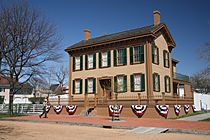
While Abraham Lincoln built his career as a lawyer, Mary managed their home and raised their children. Their house in Springfield, where they lived from 1844 to 1861, is now a national historic site. Abraham often traveled for his law work, leaving Mary to care for the children and the household alone for months. Mary always supported her husband, both socially and politically. This support was especially important when he was elected president in 1860.
Mary often cooked for Lincoln during his presidency. Even though she came from a wealthy family, her cooking was simple. It suited Lincoln's tastes, which included things like imported oysters.
Mary Lincoln as First Lady

During her time in the White House, Mary Lincoln faced many personal challenges. These were made worse by the political divisions in the country. Her family was from a state where slavery was allowed. Several of her half-brothers fought for the Confederate Army and died in battle. One brother served as a surgeon for the Confederacy.
Mary strongly supported her husband's efforts to save the Union. She was very loyal to his policies. Although she grew up in the more refined South, she was seen as a "westerner." She worked hard to be a good First Lady in Washington, D.C., which was a center of eastern culture. Critics sometimes described Mary's manners as rough or showy. She found it hard to handle the social duties of the White House. She also dealt with people seeking favors and critical newspapers during the Civil War.
Mary redecorated the White House extensively, including all the public and private rooms. She also bought new china. This led to a lot of spending, which made the president very angry. Congress eventually approved more money to cover these costs. Mary also bought expensive jewelry, often on credit. After President Lincoln's death, she had a large debt with a jeweler, which was later forgiven. Much of the jewelry was returned.
Mary suffered from severe headaches, like migraines, and periods of deep sadness throughout her life. Her headaches seemed to get worse after a carriage accident during her White House years. Her mood swings, temper, and spending habits have led some historians to suggest she had bipolar disorder. Another idea is that her symptoms might have been caused by a condition called pernicious anemia.
Mary's grief after Willie's death was overwhelming. She stayed in bed for three weeks and could not attend his funeral. She was so upset for many months that Lincoln had to hire a nurse to help care for her.
During her White House years, she often visited hospitals in Washington. She brought flowers and fruit to wounded soldiers. She also wrote letters for them to send to their families. Sometimes, she went with Lincoln on military visits to the battlefield. She hosted many social events.
The Assassination of Abraham Lincoln
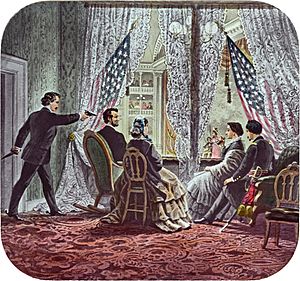
As the Civil War ended, Mary Lincoln looked forward to being the First Lady of a peaceful nation. On April 14, 1865, President Lincoln was in a good mood. Robert E. Lee had surrendered days earlier, and Lincoln was waiting for news of another surrender. Newspapers announced that the President and his wife would attend the theater that evening. Mary almost stayed home because of a headache, but Lincoln said he had to go because the public expected him.
They watched the play Our American Cousin at Ford's Theatre. Their guests were Henry Rathbone and Clara Harris. During the play, the President and Mrs. Lincoln held hands. Mary whispered to him, "What will Miss Harris think of my hanging on to you so?" Lincoln smiled and replied, "She won't think anything about it." This was their last conversation.
About five minutes later, at 10:15 pm, John Wilkes Booth shot President Lincoln. Mary was holding Abraham's hand when the bullet hit his head. She went with her badly wounded husband across the street to the Petersen House. He was taken to a back bedroom. Their oldest son, Robert, stayed with Lincoln through the night. At one point, Secretary of War Edwin M. Stanton asked Mary to leave the room because she was so overcome with grief.
President Lincoln remained in a coma for about nine hours. He died at 7:22 a.m. on April 15, 1865, at age 56. Shortly before he passed, Mary was allowed to return to his side. She kissed him and spoke loving words. When he died, his breathing became quiet, and his face looked peaceful. Many who were there noted his calm expression.
Later Life and Passing
After her husband's death, Mary received messages of sympathy from all over the world. She tried to answer many of them herself.
As a widow, Mrs. Lincoln moved back to Illinois and lived in Chicago with her sons. Her husband had left an estate that should have provided for her comfortably. However, Mary had a difficult relationship with money. In 1868, she tried to sell her personal belongings, which surprised the public. She and her youngest son, Tad, moved to Europe and lived in Frankfurt for several years.
In 1868, her former dressmaker and friend, Elizabeth Keckley, published a book. Keckley had been born into slavery and bought her freedom. Her book gave insights into Mary Todd Lincoln's life. At the time, Mary and many others saw it as a betrayal of their friendship. Today, historians value the book for showing the Lincolns' private lives.
On July 14, 1870, the U.S. Congress approved a yearly pension of $3,000 for Mrs. Lincoln. Mary had worked hard to get this pension. She wrote many letters and asked powerful people to help her. She argued that she deserved a pension like soldiers' widows, seeing her husband as a fallen commander. It was unusual for presidents' widows to receive pensions then, and Mary had upset many congressmen, making it a difficult fight.
The death of her son Thomas (Tad) in July 1871 caused Mary immense grief and sadness. Her only surviving son, Robert, was worried about his mother's behavior, which was becoming more unpredictable. In March 1875, Mary became convinced Robert was very sick. She rushed to Chicago and found him healthy. She told him that someone had tried to poison her on the train. She also spent large amounts of money on things she never used, like drapes and fancy dresses. She wore only black after her husband's death. She walked around the city with $56,000 in government bonds sewn into her clothes. Despite having a lot of money, she had an irrational fear of being poor.
In 1872, she visited a "spirit photographer" named William H. Mumler. He produced a photo that seemed to show Lincoln's ghost behind her. This photo is now known to be a trick created by using two images at once.
Because of her unpredictable behavior, Robert started legal steps to have her cared for in a special hospital. On May 20, 1875, a jury decided she should be committed to a private asylum in Batavia, Illinois.
Three months later, she planned her escape. She secretly sent letters to her lawyer and his wife, who was also her friend. She also wrote to a newspaper editor. Robert had hoped to avoid public embarrassment, but now his actions were being questioned. The hospital director, who had said Mary would benefit from treatment, declared her well enough to leave. She went to live with her sister Elizabeth in Springfield.
Mary Lincoln was released into her sister's care. In 1876, she was declared able to manage her own affairs. The commitment process caused a deep rift between Mary and her son Robert. They did not see each other again until shortly before her death.
Mrs. Lincoln spent the next four years traveling in Europe, living in Pau, France. Her health declined in her final years. She suffered from severe cataracts, which affected her eyesight. This may have caused her to fall more often. In 1879, she hurt her spine in a fall from a stepladder. In 1881, she traveled to New York to ask for an increased pension. This issue came up after the assassination of President Garfield, which raised questions about providing for his family. She faced a difficult fight because of negative news about her spending. Congress eventually granted the increase and an extra gift of money.
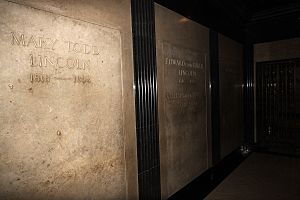
In the early 1880s, Mary Lincoln stayed at her sister Elizabeth Edwards' home in Springfield, Illinois. On July 15, 1882, exactly eleven years after her youngest son Tad died, she collapsed. She fell into a coma and passed away the next morning from a stroke at age 63. Her funeral was held at First Presbyterian Church in Springfield.
How Historians View Mary Lincoln
Historians have often seen Mary Lincoln as a First Lady who faced many challenges. They believe her personal struggles made her husband's presidency more difficult. She dealt with the deaths of two of her children, including one during his time as president.
Since 1982, the Siena College Research Institute has surveyed historians about American First Ladies. Historians rate them on things like their background, value to the country, intelligence, courage, and leadership. Mary Lincoln has consistently ranked among the First Ladies who are seen as having faced the most difficulties.
In a 2014 survey, Mary Lincoln and her husband were ranked as the 7th-highest "power couple" among First Families.
See also
 In Spanish: Mary Todd Lincoln para niños
In Spanish: Mary Todd Lincoln para niños


